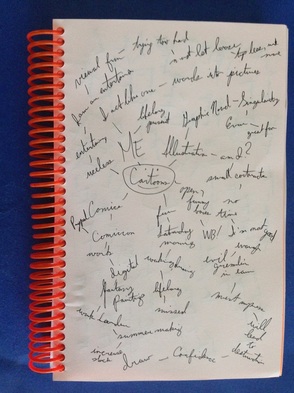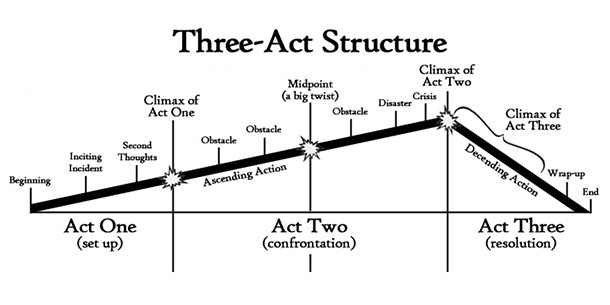Building your story -
FOUNDATION - the idea, the concept, the through line or "spine" of the work.
Making this foundation can be messy work, but it is necessary for a story to be solid. Take a large piece of paper and write a word in the center. A word that can inspire a story, something that applies to you. Now from that word do an immediate word association not thinking, just writing. Those words will lead to more words, and so on and so forth creating a web of words all stemming from the central word with which you started. Here is an example:
FOUNDATION - the idea, the concept, the through line or "spine" of the work.
Making this foundation can be messy work, but it is necessary for a story to be solid. Take a large piece of paper and write a word in the center. A word that can inspire a story, something that applies to you. Now from that word do an immediate word association not thinking, just writing. Those words will lead to more words, and so on and so forth creating a web of words all stemming from the central word with which you started. Here is an example:
FRAMEWORK - the sorting out of the brain storm. Find the building blocks for the following: Setting, Character, Conflict, Climax, Resolution.
Once you've gotten the foundation laid and all of the building blocks in place, it is time to define the story by answering the five w's; Where, Who, What, When, Why? These will help you develop a throughline/spine for your story. Once you have this worked out, now we move on to the hard stuff, How? (to which you cannot answer simply, "because.")
The 30 second elevator pitch - Now you've got all of the elements of your story laid out. Time to assemble them into their elements:
Once you've gotten the foundation laid and all of the building blocks in place, it is time to define the story by answering the five w's; Where, Who, What, When, Why? These will help you develop a throughline/spine for your story. Once you have this worked out, now we move on to the hard stuff, How? (to which you cannot answer simply, "because.")
The 30 second elevator pitch - Now you've got all of the elements of your story laid out. Time to assemble them into their elements:
- Exposition - Tell us what it is we're going to experience or has been experienced already by your characters. Tell us where they are and what they're doing (introduce the conflict).
- Now for the "why." Guide us up that slope of conflict with some rising action. Introduce plot points that help us understand the character's story trying to resolve the conflict.
- In the biggest moment, introduce the climax. The point at which we as an audience don't know what may happen to the main character in regard to the conflict because it has just exploded past the expectations of the character and the audience. This does not mean that it must be over-dramatic or violent, but rather is just a culmination of the rising action at a point where the audience has been captured and taken along for the ride through suspension of disbelief.
- Now for the descent of the falling action. No, it's not over at the climax, now we need to wrap up our story. This can take many forms as we approach the resolution.
- It could solve the conflict via a Deux ex Machina or some other less dramatic turn of events
- The conflict could be left only partially resolved leaving the audience wanting more
- The conflict could not be resolved at all
- It could also be resolved with the end result being a twist - something opposite of the expected (i.e. the villain wins, the sidekick gets the love interest, etc.).
- Now your play is done. So, can you tell this story in 30 seconds?
- Dialog - this is no longer a quick pitch by a writer, it has actors portraying characters that appeared in your 30 second pitch.
- Stage directions/emotional notes for your players - give some more details as to how the scene should look.
- VERY IMPORTANT!!!! Make sure you cover all of the points in the 30 second pitch in this next iteration.
- Back to the basics - Exposition is your friend! Let your characters describe setting, themselves and the conflict through dialog. These things do not necessarily have to happen in the order set here, for example, you can start with conflict and let that define the other two.
- You have much more room to let us understand the nuances of your story in this version. Use dialog that is packed with subtle hints and dropped points leading the audience to draw their own conclusions (for now). This is all done in the first act of your three act structure (see diagram). Now, don't get concerned, the three-act structure does not mean it has to be a full length play, just structured in a way that follows a story line format which includes the following:
- Act One - The Set up (exposition) Beginning, Inciting Incident, Second Thoughts and finished with a small climax that drives the audience into act 2
- Act Two - The Confrontation. Some ascending (rising) action is needed here to allow your characters some more depth. The diagram has three obstacles, a midpoint twist, disaster, and crisis before you reach the end of the act. For a ten-minute script, you may not get to three obstacles or a midpoint twist, but these are great plot devices to keep in mind for future works as well.
- Act Three - The Descending (falling) Action. With this, your climax begins its resolve, so you can insert the last key truths of your characters. These can come in handy to keep the twists and plot running as the audience speeds to the end with you. Don't forget to wrap up any loose ends you have left (if you want to tie them up.


